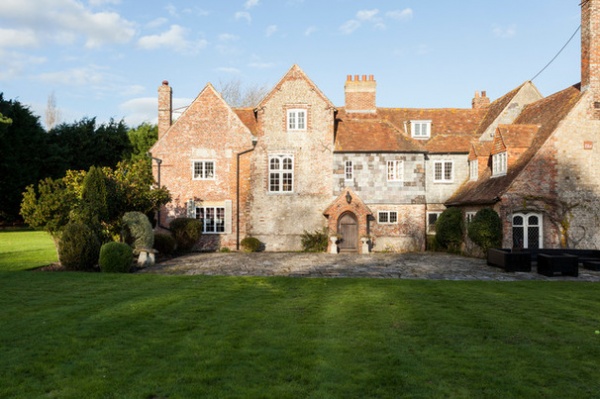The Hidden Problems in Old Houses
http://decor-ideas.org 10/29/2015 23:53 Decor Ideas
Whether you live in an older home or are considering buying or remodeling one, there are old-house problems you should familiarize yourself with. Some may be seen as mere nuisances (charming even), but others can be downright dangerous. Before you take the plunge, get to know the signs and costs associated with the repair of some common problems.

First, just what is an older home? That’s hard to define. I would say anything 30 years or older definitely qualifies as an older home, in which some of the following problems may materialize, but clearly there is no magic number.
Homes age slowly, and most of the potential problems noted in this story gradually accrue. Continuous maintenance can greatly impact a home’s life, as can the original quality of construction, but the older a home is, the more likely you are to find issues impacting its livability and even safety.

Foundation issues. If the floor is uneven to an extent you can easily see and feel while walking the home, the foundation certainly requires a thorough inspection by a structural engineer. But there are less obvious signs that commonly manifest themselves inside a home too. Doors and windows that stick or do not latch properly can be caused by foundation issues, as can drywall cracks, especially over doors and windows.
By executing a quick exterior inspection, you can check for bulges in foundation walls, or any section that does not appear plumb. You can inspect the foundation for chipping and flaking, and if you see any, use a screwdriver to confirm the hardness of the concrete.
Hairline cracks in concrete are not usually indicative of a major problem, but an inspection by a certified structural engineer is the only way to know for sure whether something is an issue. Costs to repair a foundation can be as low as $1,000, but can also run substantially more, and in some cases foundations cannot be reasonably repaired.
See why concrete wants to crack | Find a pro

Leaking roof. Water intrusion is the death of a house over time, so the soundness of a roof is critical to the health of old and new structures.
From the interior of the home, water spots on the ceiling are an obvious sign of water intrusion, but this is not always indicative of roof problems. Plumbing leaks and window leaks can also result in these stains.
Water spots on exterior walls can be a sign of flashing issues on the roof, and a quick inspection of the roof shingles or tiles can reveal common problems, such as unsecured flashing, cracked shingles, cupping and missing tiles. A quick inspection of the attic insulation for signs of moisture, and a search for daylight under the roof boards, is also worthwhile.
The cost to repair or replace a roof varies greatly, so if necessary you should get an estimate from a local roofer or contractor.
Antiquated features. The popcorn ceiling was once considered a modern touch. Today? Not so much.
Luckily popcorn ceilings can be removed. The downside is that this can cost $2,000 for a small job, and significantly more if the popcorn finish contains asbestos, which it might. A knowledgeable contractor will know if testing is required in your case.
Other issues, like out-of-style paint colors, fixture finishes, cabinets and countertops, all will result in costs to modernize. Painting is relatively easy, and even replacing fixtures can be a quick, rather painless update. But if there are significantly outdated cabinets, countertops and floor and shower tiles, you might have a $50,000 job on your hands.
Other common problems to consider include outdated plumbing and electrical systems, which can be difficult to determine without a thorough inspection by a professional.
Find a pro

Poor drainage and waterproofing. What is that musty smell in the basement? Probably mold. Back in the old days, neither underfloor drainage nor perimeter drainage was provided in a manner equivalent to what is done today. With waterproofing of foundation walls and slab floors, it is the same story.
Issues usually do not materialize in just a few years, but if your home is 50 or more years old, the perimeter and underfloor drainage is likely laughably insufficient by today’s standards, and unless it has been resolved and updated, is very likely to pose a problem at some point — if it hasn’t already. For many older homes, perimeter and underfloor drainage was not provided at all.
You might see signs of mold on the walls of an old home, but more often you will smell the musty gasses released by mold hidden in walls, attics and underfloor framing. Much has been written about the dangers of mold to the health of a structure and, more important, its inhabitants.
If you smell the noxious, gassy byproduct of the mold anywhere, consider a thorough inspection by a professional. This can potentially be a major issue, as the cost to remove mold and properly install new drainage and waterproofing in a very old structure sometimes is not economically feasible.

Outdated layouts. Petite kitchens, tiny bedrooms, narrow hallways and ladder-like stairways are all examples of old-world charm, but keep in mind there may be reasons the modern age left these trends in the rearview mirror. If you’re planning to update an old home’s design, be sure to seek the advice of both an architect and a builder before jumping in. A good architect can tell you what can be done, while a good builder can estimate what that conceptual plan might cost.
Infestations. Don’t call the ghost hunters just yet. You may hear footsteps in the attic, but believe it or not, a spectral being may not be responsible. Termites are a possibility, for sure, but other lovely pests often harboring in nooks and crannies of old homes include bees, wasps, ants, birds and rodents of every kind. These critters can do serious damage to the structural integrity of a home, as well as to the mechanical systems. Signs of rodents should be investigated thoroughly underfloor and in the attic.
Find a pro

Old windows. Old windows and doors can be a major intrusion point for water, resulting in dry rot and the mold issue described above. If poorly flashed or failing windows have been leaking for some time, properly replacing them can be a major job that includes work on the exterior facade of the home, reframing some wall and underfloor sections, and interior work, not to mention possible mold mitigation.
Look carefully at old windows on old homes for signs of staining, mold or other damage.
The allure of a home with a past, and especially a historically relevant past, can be hard to resist. Just be sure you listen carefully to the messages the home is trying to tell you. That way, you and your home can enjoy a positive future.
More
Considering a Fixer-Upper? 15 Questions to Ask First
Home-Buying Checklist: 20 Things to Consider Beyond the Inspection
Related Articles Recommended












